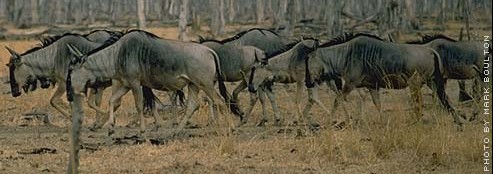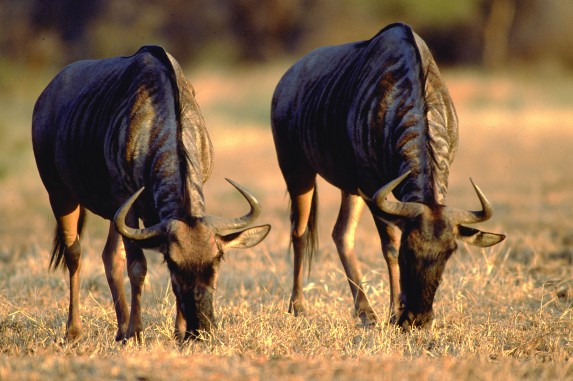|
Our
Beautiful World
|

Black Wildebeest, Free State, South Africa
Copyright: South African Tourism, Photo by ©Francois Maree
|
Family: Bovidae Subfamily Alcelaphinae Genus Connochaetes
Blue Wildebeest, Connochaetes taurinus  http://www.awf.org/wildlives/4547 There are no other antelopes that looks like the wildebeest. It looks like it is put together of spareparts. – the front could come from an ox, the back from a gazelle, the mane and the tale from a horse. This animal is making so much fun during its youthhood that it has got the name 'clowns of the savannah'.  The specimen that forms the flock in Serengetis-Mara ecosystem in Tanzania and Kenya are known as strioped, blue- or whiteberded wildebeest. Scientists are, however, sure that the blue wildebeest is limited to the southern part of Tanzania.  In the ecosystem of Serengeti-Mara those animals are yearly wandering more than 800 to 1.800 kilometers. The wandering starts most often right after they have got their calves in January or February from the short gras on the plains of the southern of Serengeti. The wildebeests first move toward the Lake Victoria, crosses the grassy savannah to the forested landscapes, and turn north into Mara. From there they begin their journey back south. They are in no doubt where they are heading, and that makes them swin over rivers and lakes in such large numbers that many are wounded, missing (especially calves), or killed by crocodiles and other predators. 
Wildebeest, Connochaetes taurinus, crossing river on migration. BBC Natural History Unit http://www.arkive.org Wildebeests are continuously wandering, and look up usable spots with gras and water. They are active both during day and night, and moves often in long rows when they are on march They may also cover long distances while trotting, but if necessary it also can run quite fast. Often you will see zebras and thomson-gazelles companying them, as well as, (of course?) many of their predators. 
flere bilder på http://www.forestryimages.org/browse/subthumb.cfm?sub=3560&start=1 |
|
|
||||||||||||||||||||||||||||||||||||
| Linker: | |
| www.ultimateungulate.com | |
| www.ultimateafrica.com/Wildebeest_migration.html | |
| www.botswana.co.za/africa_wildebeest.html | |
| Wildebeest, from African Wildlife Foundation |
 ANIMALS over 250 |
 BIRDS over 500 |
 FLOWERS over 225 |








